How Thick is 12-Gauge Wire (Diameter, Area, Tips)

You may be wondering exactly how thick 12-gauge wire is, especially if you’ve been advised to replace 14-gauge wire.
12-gauge wire has a diameter of 0.0808 inches or 2.0525 mm, approximately 1/12 of an inch or 2 mm. It’s a little thicker than 14-gauge wire but thinner than 10-gauge wire. It makes it about as thick as a nickel or 20 sheets of paper. It’s usually required for a 20-amp circuit and some 15-amp circuits.
Continue reading for more details.
Thickness of 12-gauge Wire
Exact Thickness
The exact thickness of a 12-gauge wire is 0.0808 inches. More details are given in the table below in different measures.
| Diameter | Cross-Sectional Area | ||
| In Inches | In Millimeters | In Inches | In Millimeters |
| 0.0808 in | 2.0525 mm | 0.005129 sq in | 3.3088 mm2 |
Normally, when we speak of “12-gauge wire” in the United States, we mean 12-gauge in the AWG (American Gauge Wire) system, also called the ‘Brown and Sharpe Wire Gauge.’ The exact diameter is 0.0808 inches (2.052 mm), with a cross-sectional area of 0.005129 sq. (3.3088 mm2).
The 12-gauge equivalent in the SWG (Standard Wire Gauge) system is 0.1040 inches (2.642 mm), which is thicker than a 12-gauge AWG wire. The closest equivalent in SWG (of 12-gauge AWG) is 14-gauge wire, which is only slightly thicker at 2.108 mm.
The resistance of 12-gauge (copper) AWG wire per 1000 feet is 1.5844 Ω/kft (or 5.1983 Ω/km per 1000 m) at 20°C (68°F). The current in amps is 41 for chassis wiring and 9.3 for power transfer.
Note that this is the diameter of a solid wire, as a stranded wire has a slightly larger diameter due to the separate strands.
Types
Below is a sample of 4 types of 12-gauge wire.
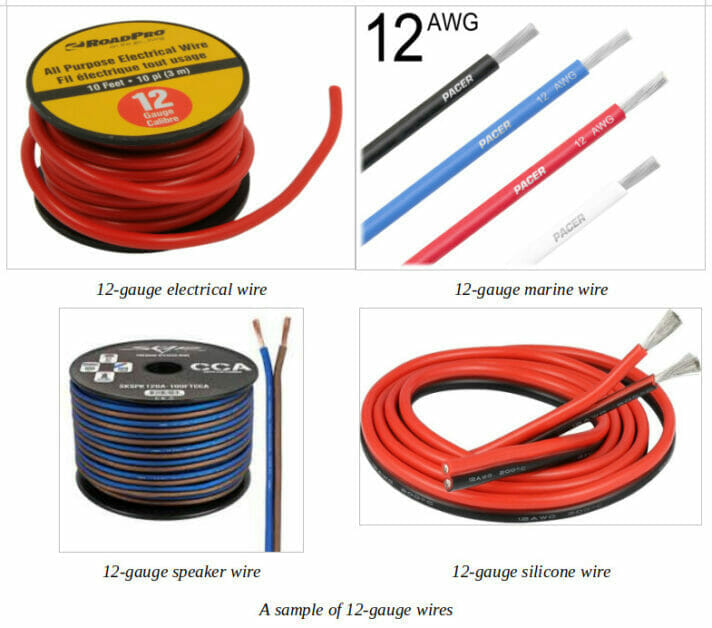
Comparisons
A comparison of 12-gauge wire with other adjacent gauge wires can help to get an idea of how thick it is.
12-gauge wire is thicker than 14-gauge wire and thinner than 10-gauge wire. Refer to the chart below to see the difference.
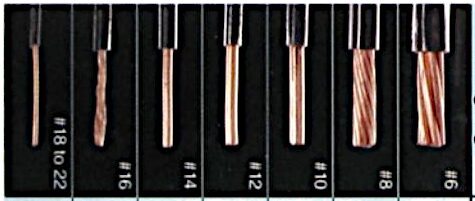
If you need to decide between using a 14- or 12-gauge wire, usually for a 15-amp circuit, this is how the two look side-by-side:
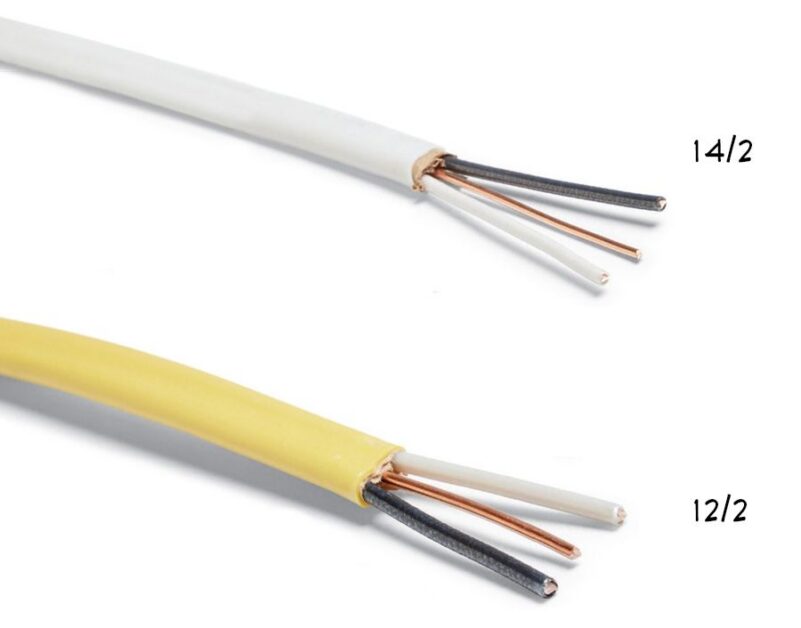
Normally, a 15-amp circuit requires a 14-gauge wire, but a 12-gauge wire may be necessary if it’s a bit heavier appliance that doesn’t require a 20-amp circuit or has a long run. A 12-gauge wire will be better for preventing excess voltage drop over a long distance.
However, remember that a 12-gauge wire will be more expensive than a 14-gauge wire.
Approximations
It might make it easier to know how thick a 12-gauge wire is by comparing it with other known objects instead of knowing the exact size.
12-gauge wire is approximately 1/12 of an inch or 2 mm. It is about as thick as a nickel, and these items:
- About 20 sheets of paper
- About 3 credit cards
- A toothpick
- A ruler
- A knitting needle
- A grain of rice
- A thin ceramic tile
So, it’s stiff enough, not easily to bend by hand. Compared to thinner 14-gauge wire, 12-gauge wire is usually harder to bend around corners and snake through openings.
Uses of 12-Gauge Wire
Electrical Uses
12-gauge wire is designed to allow up to 20 amps of current to pass through, usually on a 120-volt circuit.
It’s usually required for appliances such as heavy light fixtures, toasters, blenders, mixers, and microwave ovens. Some dishwashers, gas ranges, and washing machines also require 12-gauge wire. Check the manufacturer’s recommendations to know for sure.
A circuit that uses 12-gauge wire typically has 20-amp outlets and a 20-amp circuit breaker. GFCI protection may also be required. So, if you see a 20-amp outlet or circuit breaker, it’s probably connected by a 12-gauge wire. You cannot use a thinner 12-gauge wire on it.
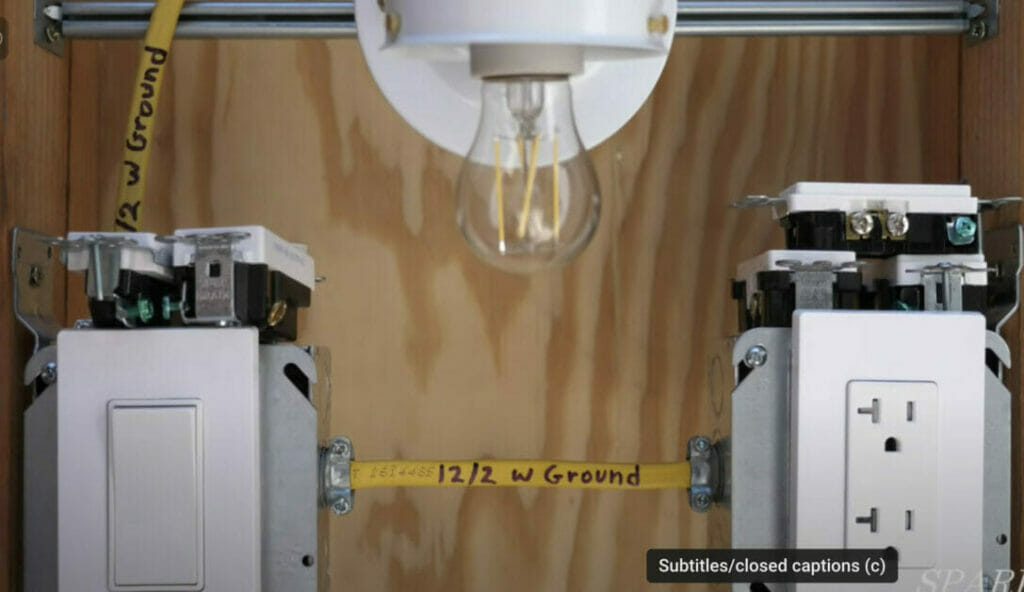
Creative Uses
The thickness and stiffness of 12-gauge wire make it useful in more ways than just letting up to 20 amps of electrical current pass through.
Here are a few non-electrical uses of 12-gauge wire:
- A stiff bracelet
- A wire-sculpted ring
- A choker
Amps Rating of 12 Gauge Wires
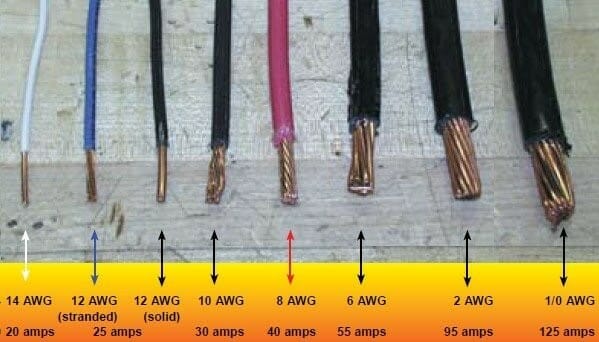
The maximum amount of amps a 12 gauge wire can handle is 20. And the 20 amps can be ferried to 400 feet in a 12 gauge copper wire–insulated. If the wire stretches beyond 400 feet, voltage loss begins to occur. Increasing the voltage solves the problem. A higher gauge wire can transport current to greater distances than smaller gauge wires.
The 12 gauge wires, though rated at 20 amps, can handle up to 25 amps. However, higher amps values can fry your wires and circuit breaker. It is worth noting that the higher the heat rating, the higher the amps. In that sense, aluminum wires have lower conductivity when compared to copper wires; hence, they will carry lower amps relative to copper wires – as the heat rating increases.
The Thickness of a 12-gauge Wire
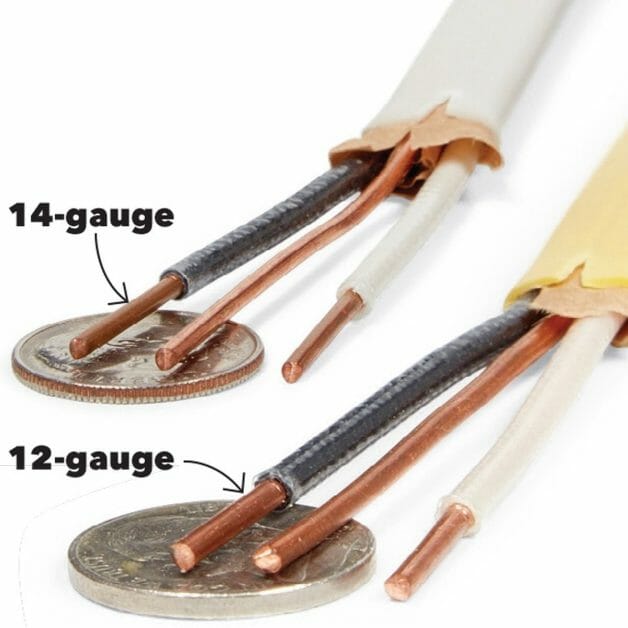
As mentioned earlier, the thickness of 12 gauge wires is 2.05 mm (diameter). The gauge and thickness of a wire have a relationship. Thinner gauges have higher resistance to current flow. Since voltage varies indirectly with current, a decrease in current in thinner gauge wires) cause a corresponding increase in voltage potential across the wire. The exact explanation for this deviation is that thinner wires have less electron charge density. The electrons are the mediums of electrical conductivity. Thicker wires have a higher electron charge density.
FAQs
- How do I know if I need a 12-gauge wire instead of a 14-gauge wire?
- It all boils down to the amps, folks! If you’re dealing with a 20-amp circuit, 12-gauge wire is your go-to. For 15-amp circuits, 14-gauge wire usually does the trick. But if it’s a long run or a bit of a heavier load, upgrading to 12-gauge is a smart move to prevent voltage drop.
- Why does 12-gauge wire come highly recommended for certain appliances?
- Heavy hitters like toasters, blenders, and microwaves love the extra muscle 12-gauge wire brings. It’s all about handling that 20-amp current like a champ, ensuring your appliances run smoothly without a hitch.
- Is it a big deal to switch from 14-gauge to 12-gauge wire?
- Think of it as moving from a country lane to a highway – more room, less congestion, and a smoother ride for the electric current. It’s a bit of an upgrade but comes with a tad higher price tag.
- How can I visually compare the thickness of 12-gauge wire to common objects?
- Imagine stacking 20 sheets of paper or lining up three credit cards – that’s your 12-gauge wire. Or picture a nickel; it has the same kind of heft. It’s the kind of wire that holds its own yet is flexible enough to play with your wiring whims.
- Why is the exact thickness of the wire important to know?
- Precision, my friends, is the name of the game! The exact thickness dictates the wire’s ability to carry current. A thicker wire like the 12 gauge means lower resistance, making it a top choice for higher amp circuits.
- Is 12-gauge wire only used for electrical purposes?
- Oh, the tales 12-gauge wire could tell! Beyond electrifying your home, it’s been known to moonlight in creative projects like stiff bracelets, wire-sculpted rings, or even a minimalist choker. It’s not just about carrying current; it’s about carrying style!
- What’s the difference between solid and stranded 12-gauge wire?
- Solid wire is your sturdy, reliable buddy, perfect for installations requiring consistency and firm connections. On the flip side, stranded wire is the flexible friend, easier to route through tight spots, and better suited for situations where the wire might be moved around.
- What if I still feel unsure about which gauge wire to use?
- When in doubt, call in the cavalry! A licensed electrician can steer you in the right direction, ensuring your wiring is up to code and up to the task at hand. Safety and precision are the keywords when venturing into the wired world!
References
Website Resources:
- 12-gauge electrical wire. https://www.roadprobrands.com/products/truck-and-auto-supplies/vehicle-parts-and-accessories/wiring-and-electrical/12-gauge-10-all-purpose-electrical-wire-spool
- 12-gauge marine wire: https://www.pacergroup.net/12-gauge-marine-wire/
- 12-gauge silicone wire. https://www.amazon.com/BNTECHGO-Silicone-Flexible-Insulation-Stranded/dp/B08C9MX6JP
- 12-gauge speaker wire. https://www.ebay.com/p/22045127482
Books:
- B & D. The complete guide to home wiring: A comprehensive manual, from basic repairs to advanced projects. Black & Decker Home Improvement Library. Creative Publishing International. 2001
Website References:
Sparky Channel
